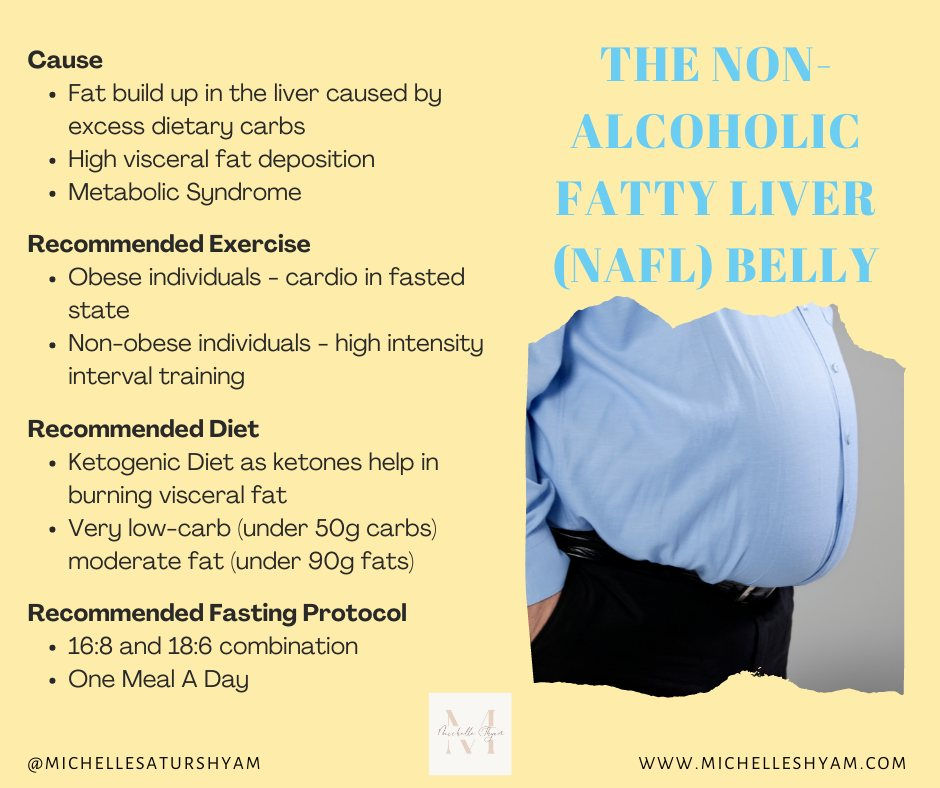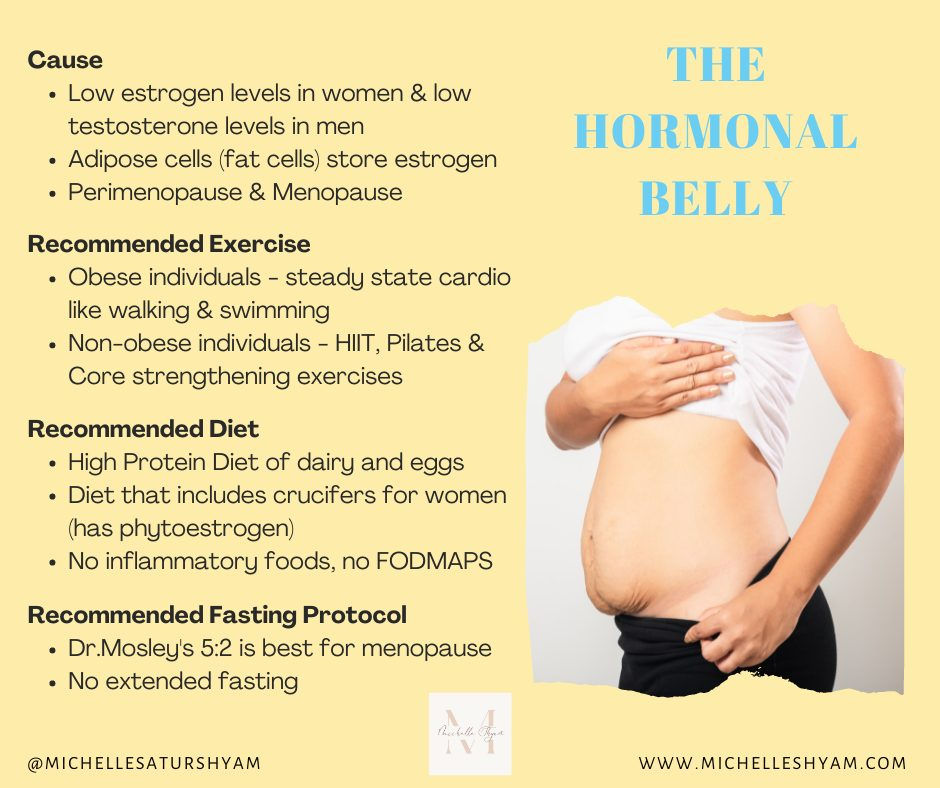The Terrible, Horrible, No Good Very Bad Belly
- Michelle Shyam

- Mar 17
- 6 min read
Did you know your belly can tell you a lot about your health status? If your waist circumference is more than half your height, you have a belly problem and it may be the reason why you are NOT losing weight in spite of your best efforts.
From my research and study, it seems that for each of the belly types, we need a different diet, exercise and fasting regimen. For example, a fatty liver will not do well on carbs. A hormonal belly will not do well with high intensity workouts.
Belly fat is often the hardest to lose because we don't know what we are dealing with. While most dieticians say you can't spot reduce belly fat, I beg to differ. It is possible to do so once we understand our body type, and what works for that particular body type. We all look our best when we have a slimmer waist (men and women), that is just how the human body is aesthetically pleasing to the eye.
Here, I am sharing real life examples of how I've successfully helped my clients lose different types of belly fat.
Non Alcoholic Fatty Liver Belly

A person with a NAFL belly looks similar to the one in the picture - there is swelling and hardness in the upper abdomen region along with a protruded and slightly sagging belly. The fat region is concentrated more on the upper region of the waist just below the rib cage. NAFLD is not the same as Alcohol associated fatty liver disease, but it is still a dangerous situation to be as NAFLD if not treated swift enough can lead to cirrhosis. The good news is that with proper diet and exercise one can reverse NAFLD in 3 months!
A NAFL belly is characterised by the accumulation of fat deposits on the liver. This can happen both for obese and non-obese individuals. In non-obese individuals they do tend to have a higher percentage of visceral fat (than subcutaneous fat) or visceral obesity. When one consumes beyond one's carb threshold, the excess glucose is converted and stored as glycogen. Since our body has only small reserves for glycogen, and once that is full, the liver converts the excess glycogen to fat. So essentially, excess dietary carbs that our bodies do not burn out are converted to fat! This fat is distributed to adipose cells (fat cells) and later dumped onto surrounding organs - mostly the liver and pancreas.
So the approach to losing the NAFL belly is very simple - burn the excess glucose! This can be done through stricter fasting windows like OMAD (one meal a day) or 18:6. Exercises such as cardio which rely primarily on the glucose pathway can be extremely beneficial. Although I do not recommend HIIT for overweight or obese individuals (as they can risk injury). I do recommend it for those who are fairly active and slightly overweight. Exercising in a fasted state in the morning for 30 minutes is effective too.
With regard to diet, any diet that keeps carbs extremely low is the most effective in reversing NAFL and burning visceral fat. One such diet is the ketogenic diet. Another version of this is the Carnivore diet. Even a low-carb (under 50g carbs) with moderate fat diet can help. If you don't want to go with labels, then the first step is to quit simple and complex carbs - sugar, rice, rotis, fruits, honey.
The best way to go about this is to run your LFT (liver function tests) with your primary physician. Liver enzyme tests like SGOT and SGPT are some of the markers that are helpful. More importantly, do not ignore your expanding waist line. If you have a waist that is more than half your height, please seek help and resolve to make dietary changes.
The Hormonal Belly

The Hormonal Belly is called so because one of its chief causes is a drastic shift in hormonal balance right around the time when women are approaching menopause. With menopause comes a reduction in the production of estrogen by the ovaries, making the adrenal glands take over the estrogen production. The adipose or fat cells around the belly have the highest estrogen receptors in the body (as well as in the arms). So when the body slows down production of estrogen, through a series of pathways and signalling, the adipose cells store estrogen. This causes the cells to expand and grow large causing a protruded belly right below the naval.
While men do not undergo menopause, they do get a 'hormonal' belly when estrogen is high. The enzyme aromatase converts testosterone to estrogen in men. So when estrogen is high, it signals the body to slow-down testosterone production in men. High estrogen in men causes the development of 'man-boobs' as well.
My recommendation with respect to diet if you have a hormonal belly due to perimenopause or menopause is to:
Drastically reduce your consumption of refined carbs, sugar and gluten products.
Increase protein, especially dairy and eggs as they are produced by the animal due to estrogen. If you can tolerate plants, then cruciferous vegetables with their phytoestrogens will be effective in restoring estrogen balance. Increase in animal-based protein for men also raises testosterone.
Increase in saturated fats - as they are anti-inflammatory. With accumulation of estrogen in adipose cells, come also the 'cytokine storm'. You don't have to go the Keto route, but just a moderate amount of saturated fats will help.
Dr. Mosley's 5:2 pattern of Intermittent Fasting might suit women during this phase. Here, 5 days a week you eat usual 3 meals, and remaining 2 days a week reduce calorie consumption to 500kc (for women) and 600kc (for men).
The Insulin Resistant Belly

One of the most common causes of belly fat today is due to Insulin Resistance (otherwise known as The Metabolic Syndrome). This kind of belly is characterised by an overall concentration of fat around the girth, giving it a "tyre" like appearance. This fat is dangerous as it mostly accumulates around the organs and is called visceral fat. Insulin resistance brings with it a host of other problems like Non alcoholic fatty liver, Diabetes T2 and PCOS.
Insulin Resistance happens when insulin receptors of the muscle, liver cells and adipose cells no longer respond to the uptake of glucose from the blood. One of the roles of insulin is to move the circulating glucose in the blood stream into the cells. So when the insulin receptors in these cells stop responding, it signals the pancreas to produce more insulin and you have a situation where blood glucose AND insulin are both high. This is insulin resistance. Insulin is also the "fat storing" hormone. Excess glucose, through a series of pathways is converted to fat!
So, belly fat is largely due to the excess consumption of carbohydrates. This is because the body has a very limited reserve for storing glycogen (glucose is stored as glycogen), but has an unlimited storing capacity for fat. One way to know if you are headed down this path is to keep a watch for your increasing waist measurement. WSR (waist to stature ratio) is the best predictor of IR. As a rule of thumb, your waist should not be more than half your height. WSR <0.5 is the healthy range.
The recommended diet is to go very low carb, but not yet Keto. As there are studies that prove that a high fat diet might not be a good option to address IR. In some cases, high fat can worsen IR by lowering insulin sensitivity. So if you are insulin resistant, you might want to dial back on those bullet proof coffees and keto bombs! Going with a high protein, moderate fat, low carb diet works best to burn the IR belly fat. Protein also stimulates the production of Glucagon, the "fat burning" hormone which is produced by the pancreas. It balances the effect of Insulin.
With respect to exercise, brisk walking is the most effective, as it puts you in the 65% max heart rate range - the fat burning zone. Unlike other intense exercises, walking does not spike insulin, but works to lower it. Even weights and resistance training exercises are effective because it also utilizes the excess circulating blood glucose to supply energy needs during the workout. High Intensity Interval Training (HIIT) exercises are not recommended as they can cause elevated insulin levels to not drop and can promote the excess stimulation of the stress hormone cortisol. Cortisol signals more glucose release into the blood stream from the liver. So it's best to lay off HIIT and anaerobic activities if you are insulin resistant.
Intermittent fasting is the best way to lower insulin and from my experience following a combo of 16:8 and 18:6 is a good approach. You do not need to go for strict fasting windows as it may be detrimental to your success. Also, it is best to avoid snacking between meals if you are not yet on the fasting band wagon. Limiting the frequency of eating without fasting has similar benefits.
Lift Mostly Weights is my one of my fitness and nutritional programs where I help folks reduce belly fat through the right diet and exercise regimen. My weight loss programs Eat Mostly Meat and Eat Mostly Protein (for vegetarians) have similar approach where I calculate my client's carb threshold. Not everyone needs to go low-carb. But mostly everyone needs to have adequate protein and fats to offset the damages of carbs.




Comments